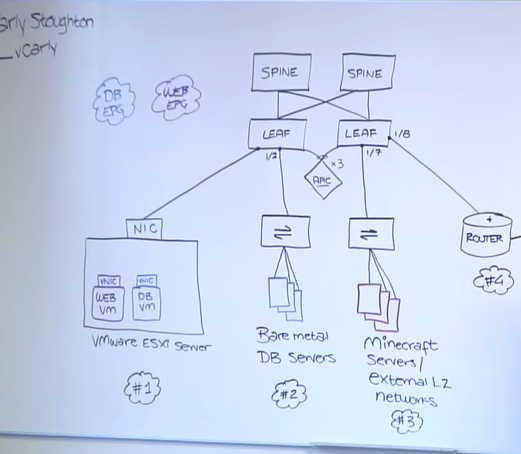Posts Tagged ‘SDN’
Networking Field Day – Afterwards – Brocade SDN
I wanted to start off stating Brocade broke one of the biggest barriers with getting involved with SDN and labbing out the technology. Brocade offers a free download of their Vyatta Controller! With this free download you can run a 5x node SDN network for one year, included with 60x days of support! This eliminates a huge obstacle of actually purchasing the software, sure you may still require the hardware but Brocade SDN Solution features support for OpenDaylight/OpenFlow so you do have many different hardware options.
Now, that I got that out of the way my two favorite pieces of the Brocade was 1. The technical overview of the Vyatta controller and it’s architecture, it was great to see how to the services overlay on each other and what makes it tick. Usually when it comes to some type of SDN solution it’s usually presented as some type of application that does magic. In this case however Brocade definitely did their due-diligence to cover how their controller actually functions. The 2nd thing I loved about this presentation was just how frank and up-front the presentation was. My favorite quote of the whole the presentation was “We know how to code, we went to school. We chose not to program we went into networking.” I can’t say how happy I was to hear someone actually say this! However like it was mentioned in the presentation it appears to be a natural evolution of the field.
As the presentation continues, you really get a sense about how far along the Vyatta controller has come along once the conversation steers towards volumetric traffic management. Having the additional and built-in monitoring of the traffic flows with sFlow and OpenFlow addressing a level of application performance management many current-day data centers frankly do not even have in place today just shows how grown up the tool is becoming. This is built upon again with the flexibility to handle elephant flows differently than other typical data flows, if you are not familiar with the term elephant flows these are just traffic flows that transfer a very high amount of traffic (IE: Something like backup traffic). I can’t tell you how many few companies I’ve worked with in the past that have actually taken into account these ‘elephant flows’.
Now, I don’t want to ruin the whole presentation for you, if you have not watched it yet I highly recommend you give it a watch. There also a great slide in there about Ivan! If you think SDN is still a mystery it’s time to get that Vyatta controller downloaded and running! No more excuses!
You can download the Vyatta Controller here.
Brocade’s Networking Field Day #9 videos can be found here:
Networking Field Day – Afterwards – Cisco ACI
I first need to give a shout out to @_vCarly and her amazing skills at the white board, I only wish my white boarding design were half clean as that! If @_vCarly were to a host a white boarding session at CLUS this year I would most likely attend!
I suppose we should discuss the actual presentation now! Like probably many of you I have heard an awful lot about Cisco SDN and Controllers (Cisco ACI) however until now it has all been theory and hear-say. I can finally say I’ve seen the GUI and got to hear a deep dive of how this new architecture is supposed to work. Now, that I have seen it I am believer there is a lot of potential here and allow us to re-think the way we consider designing Data Center networks and here is why I think that:
- Building around the application, with this new design model we are almost forcing the application designer & server administrations to tell how their servers/applications work and communicate on the network. I have a spent a lot of time with AppDev’s going over what their application does and what else the App communicates in order to troubleshoot an issue. This approach removes much of the hassle without ever seeing the hassle. Future engineers might not know ‘the struggle’ of discovering an application via packet analysis and bridge calls.
- Deployment Orchestration – by specifically calling out the application and the service chaining from the get go, deploying a new application is much more streamlined and simplified in the long run when internal process are stream-lined. Eliminating the time-consuming need to:
- Login to multiple networking devices to configure SVI’s & Trunks
- Login to multiple firewalls creating the appropriate rules.
- Login to Load balancers and creating devices pools, health monitoring, virtual servers, and so forth.
- Troubleshooting and flow monitoring – Out of the box this box will be watching flow statistics. So tracking traffic statistics can easily pin-point packet loss and drops. Which may mean bad news some of the simpler NMS solutions out there unless they start looking beyond the typical Up/Down & Interface utilization mantra.
- Something that was brought up on Twitter post-event was the support for SNMP, which is a great question since SNMP was never mentioned (in any of the SDN-related presentations for that matter).
Now, with all that said and the fact Cisco ACI builds a Data Center around EPG’s (End Point Groups) I really look forward to this new design architecture. It’s probably going to be a bit more tedious up front since some applications will need to be called out specifically instead of going “O, that is a web server. Place it on this VLAN” but in the long run this will streamline many different parts of data center operations.
Links to the Networking Field Day 9 presentations below:
Understanding the Cisco ACI Policy Model
Cisco ACI Overview w/ Soni Jiandani & Joe Onisick
Networking Field Day 9 First look: Generation-SDN -Part 1
If there is one topic prevalent at Networking Field Day #9 it is SDN, well okay maybe this is one of the most prevalent topics in the networking industry right now. Among many the presenters at Networking Field Day #9 quite a few of them bring some flavor of SDN or SDN-WAN’s to the table.
A few of the presenters:
- Cumulus Networks – A Linux based SDN-powered data center we definitely have a great foundation here. While looking around Cumulus’ website I really do like the sheer amount of information available on their website.
- Validated Design Guides – Pretty extensive design guides covering guidelines for implementing Cumulus network devices with VMWare, OpenStack, & Big Data (Which are definitely worth reading)
- Looks like they recently released a new version v2.5, and they have presentation available here. Definitely some good information in there.
- Probably the most important option (in my option), is the ability to ‘test drive’ this solution. You can request access to their remote lab to get a better look and feel for the Cumulus Solution.
- Considering this a *nux Distro, some of the backend process are common in the industry. Namely Zebra & Quagga for instance. It’s been a while since I’ve worked these, so whether we consider SDN a brand new technology or a shiny new tool to configure your network. Deep down it still utilizes the same backend methods you and I are familiar with.
- CloudGenix – An SDN-WAN Solution, this is an interesting twist of the SDN perspective because up until now when I heard the term SDN I usually associate it within the Data Center.
- A few noticeables, you can request beta access here, and stay up to date with CloudGenix’s progress.
- I really like how companies are embracing this openness.
- To me this sounds like it could be a very useful & popular take on the SDN-perspective, there are many companies out there with 100’s of remote sites that could definitely benefit from the SDN model. Keeping policies in sync across that many locations is always a tough business challenge and drastically affects the troubleshooting process, so I can’t wait to see CloudGenix’s approach and how they can aid in this issue.
- Using the SDN with the WAN in my opinion may also present a different set of challenges.
- Where as you typically have a stable and reliable underlay within your data center, the enterprise WAN may or may not have that same level of reliability & stability in the WAN underlay. Does that introduce any new issues to the SDN model, and if so how does CloudGenix approach those new challenges?
- A few noticeables, you can request beta access here, and stay up to date with CloudGenix’s progress.
Both of these companies should be presenting unique and interesting presentations, after all SDN certainly has a lot of buzz in the networking industry and now we are looking at different flavors of SDN. These different flavors of SDN could really affect the future of network implementations. Now a small part of me is wondering, can I get an SDN-Integration application to make sure my SDN-WAN and SDN-Data Center mingle in harmony? Cause we all know sometimes what is good for the goose is not always good for the gander.




